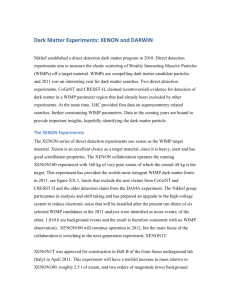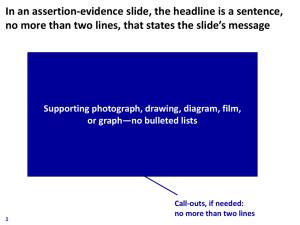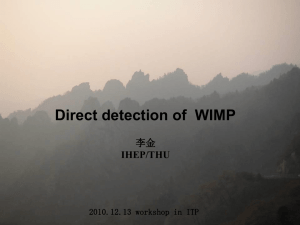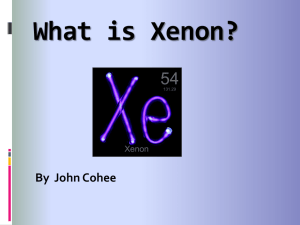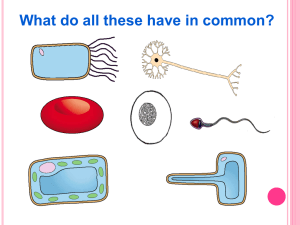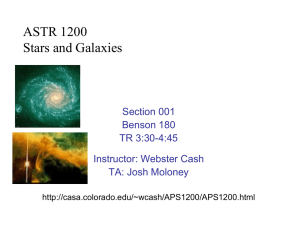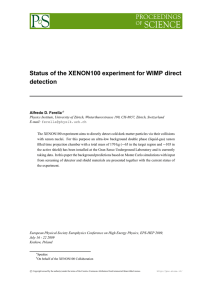Ed Daw`s seminar - Particle Physics and Particle Astrophysics
advertisement
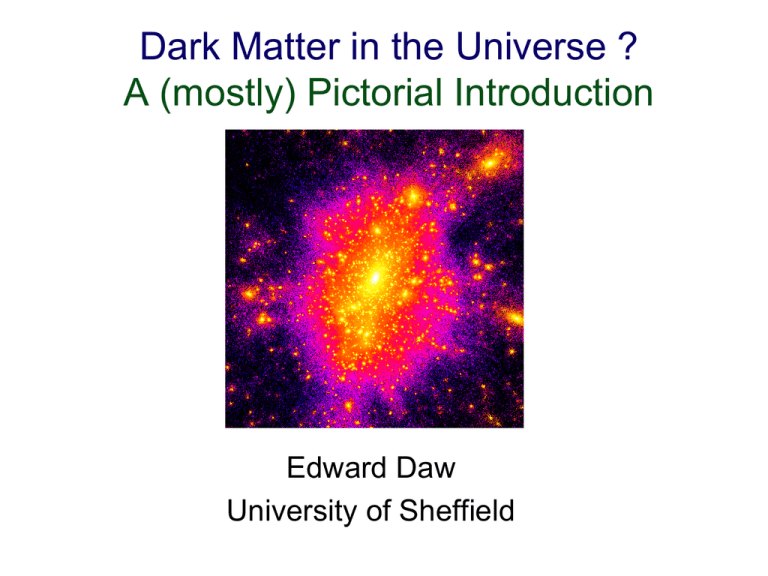
Dark Matter in the Universe ? A (mostly) Pictorial Introduction Edward Daw University of Sheffield A Spiral Galaxy-NGC3198 In Ursa Major (Great Bear / Plough / Big Dipper) constellation. Distance is 9.1Mpc, or 30 million light years. For comparison, distance from Earth to the galactic centre is a factor of ~1000 less, ~ 30 thousand light years 33 thousand light years Dust, Gas, and Debris Sombrero Galaxy - NGC 4594, in Virgo. Hubble Space Telescope Image http://antwrp.gsfc.nasa.gov/apod Horsehead Nebula In Orion, 0.9m telescope, Kitt Peak National Observatory, U.S.A. Image is 2.7 by 1.8 light years, distance is 1.6 thousand light years Pink background is hydrogen emmission from IC434 emmission nebula. http://antwrp.gsfc.nasa.gov/apod Question: Is the mass in the universe all observable through emmission or absorbsion of electromagnetic radiation ? Dark Matter ...is matter that does not shine or absorb light, and has therefore escaped direct detection by electromagnetic transducers like telescopes, radio antennas, x-ray satellites... It turns out that there is strong experimental evidence that there is more than 4 times as much dark matter as luminous matter in the observable universe Evidence for Dark Matter Use the fact that massive objects, even if they emit no light, exert gravitational forces on other massive objects. m1 r12 m2 Study the motions (dynamics) of visible objects like stars in galaxies, and look for effects that are not explicable by the mass of the other light emmitting or absorbing objects around them. Rotation of Stars around Galactic Centres We can measure how fast stars rotate around galactic centres by looking at the frequency shift of known spectral lines originating in the stars due to the Doppler effect. Star’s motion towards you, relative to the galactic centre alters wavelength of light Need World’s largest telescope... Some Results This is what we expect.... v ...but here are some typical results DISK RADIUS r Wavelength shifts are about a part in 106. These are hard measurements. Possible Interpretations -Maybe there is more matter in galaxies that we have not observed. (WHAT ? Faint stars ? Planets ? Rocks ? Gas ? Dust ? Exotic Particles ?) Need about 10 times as much dark matter as visible matter to explain the rotation curve discrepancy ! -Maybe Newton’s law of gravitation is wrong for very large distances or very small accelerations. (A alternative theory (MOND) has been seriously proposed, cannot yet rule this out) Gravitational Lensing of Light Bending of light in gravitational fields can make lenses out of massive objects NO LENS LENS US SOURCE LENSING OBJECT Strong or close lens, expect a ring of light, or a ring of images in the presence of the lens. When not resolved, expect increased intensity. Galaxy Cluster 0024-1654, Hubble Deep Field 1.4 million light years Reconstructed Matter Distribution in CL0024-1654 [Tyson et al., Ap. J. 498 L107-110, 1998] How Much Dark Matter in Clusters ? Need about 10 times as much dark matter in the overall cluster as observable in the individual galaxies to explain the observed microlensing Galaxies are made up of about 10 percent visible matter and 90 percent dark matter, whose nature is currently not understood. Galaxy clusters that have been measured are made up of about 10 percent visible matter and 90 percent dark matter, which means that on a galaxy and cluster scale, only a few percent, perhaps lower, of the matter is solidly understood. ...OR you could consider modifying Newton’s law of gravitation, but the modifications proposed to explain both rotation curves and cluster lensing are so complicated that nobody except the author claims to understand them ! What Could Constitute the Dark Matter (1)? IDEA 1 : Rocks -from pebbles to giant planets like Jupiter. If there are enough of them, they could make up the dark matter. Jupiter-size and above planets are a serious contender, and are called MACHOs by the community - MAssive Compact Halo Objects. IDEA 2: Neutrinos Light, neutral particles of which at least some have a small mass. Produced in enormous numbers in stars and possibly at the big bang. If there are enough of them, they could (maybe) be the dark matter. What Could Constitute the Dark Matter (2) ? IDEA 3: Black Holes Don’t emit significant amounts of light, can be very massive. Would need lots of them. IDEA 4: Cosmic Strings Dense filamentary structures that some theorists think could thread the universe, giving rise to its presentday lumpiness. Currently disfavoured by cosmological data, but may come back into vogue sometime. What Could Constitute the Dark Matter (3) ? IDEA 5: Axions Very light particles, mass around 1/1,000,000,000,000 of an electron. Needed for building most realistic models of the neutron from standard model particle physics. Not detected. To be the dark matter, there should be around 10,000,000,000,000 per cubic centimetre here on Earth. IDEA 6: WIMPS (for the rest of this talk) Particles having mass roughly that of an atomic nucleus, could be as light as carbon or as heavy as 7 nuclei of xenon. Need a few per litre to constitute dark matter. Unlike nucleus, only interact WEAKLY with other matter, through the same mechanism that is responsible for nuclear beta-decay. Detectable WIMP Interactions WIMPs interact WEAKLY with ordinary matter. Ordinary matter consists of protons, neutrons, and electrons. Think of this interaction as classical, ‘billiard ball’ scattering, except that the probability of scattering occuring is absolutely tiny. The billiard balls are the incoming WIMP and an atomic nucleus. The WIMP collides with the nucleus, causing it to recoil. INCOMING WIMP TRAJECTORY Detecting the WIMP Interactions The nucleus recoils after being hit. The kinetic energy it gains is enough to ionize the atom, creating a positively charged nucleus and a free electron. EXAMPLE DETECTION SCHEME: + NUCLEUS e- The struck nucleus is part of a molecule. The molecule is ionized, but the ionization electron recombines with the other remnant parts of the molecule to form an excited molecular state. This state then decays back to the ground state with the emission of light of a characteristic frequency Zeplin II - A Scintillator Detector for WIMPs Detector houses 35kg of Liquid Xenon, which is a scintillator. The signal is flashes of 175nm (ultra violet) light on de-excitation of a Xenon molecular excited state after a WIMP collision. 7 Photomultiplier tubes are used to collect the scintillation light. Why This Is a Hard Experiment BACKGROUNDS Lots of other things can cause the xenon to emit scintillation light. a) Background radiation in the form of gamma rays emmitted by impurities in solids surrounding the detector, or in the detector itself. b) Background radiation in the form of neutrons. Neutrons are the most troublesome problem. Some are emmitted by the detector or surrounding material. The rest have their origin in cosmic rays from space. Shielding the Experiment from Cosmic Rays Boulby Mine, Near Whitby, North Yorkshire. 1.1km deep potash and rock salt mine. Temperature at bottom is between 100 and 130 farenheit. Our lab is now air conditioned. Laboratory Infrastructure The UKDMC runs 3 experiments that are now being installed in the underground lab - Zeplin II, Zeplin III (both liquid xenon) and DRIFT (gaseous CS2 gas time projection chamber). Conclusions There is MUCH MORE to the Dark Matter problem than I have had time to discuss in this talk. Other detection methods (solid Gemanium and Silicon crystals, Calcium Tungstate, Sodium Iodide) There is also MUCH MORE to the technology of liquid xenon based detectors - gamma background rejection, scale up to huge detectors with around a tonne of liquid xenon. There is also MUCH MORE to the dark matter problem axion searches, dark energy and cosmology Take PHY323 in your 3rd year, or check out the course web site at http://www.shef.ac.uk/physics/teaching/phy323/

